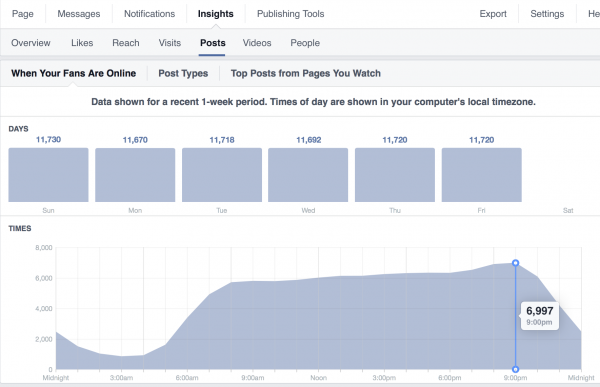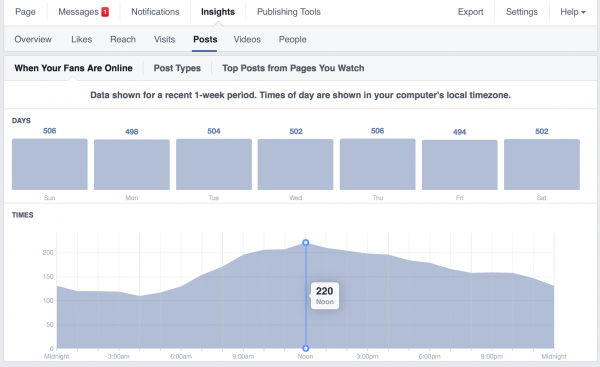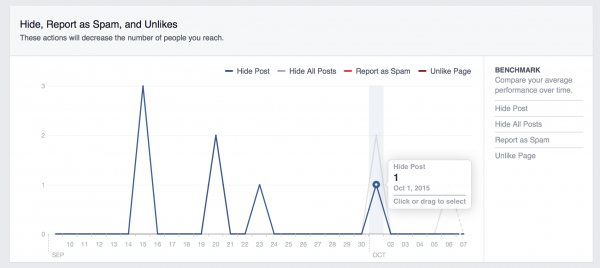Use these content tests and learn how to reach more people on Facebook with your posts
There’s nothing more frustrating than looking at your Facebook page, with 20,000, 30,000, 40,000 or more fans, and seeing that your posts are only being seen by 100 people. 500 people. 900 people.
The days of posting whatever you want and getting it seen by everybody who “likes” your page are gone.
Now, Facebook decides who sees what. I genuinely believe they’re doing their best to serve up the best content (and make money with ad revenue), but I also think that copying Google and trying to serve up the content that they think is most relevant isn’t user-friendly. Imagine if you signed up for an email newsletter that you wanted to receive, and then Microsoft Outlook decided whether or not to put it in your inbox.
[text_ad]
But that’s the reality of what publishers are up against. And depending on who you talk to, they might tell you that posting more got them higher visibility, whereas another will tell you that the more they posted, the less visibility they got.
And it doesn’t just come down to how often you post, it’s also what you post. At our most recent Mequoda Summit, one publisher said they were able to increase their visibility by posting popular articles from other sites, in between their own articles.
Based on our many discussions with publishers like this, and the vast research we’re always catching up with online:
1. Test frequency
When you start testing, I’d recommend dropping your frequency, and then building up. For the first week, try cutting your frequency in half, or even more, depending on how much you post. Consider this your baseline, and for the first week, see how this effects your visibility toward the end of the week.
2. Start adding image posts in between your link posts
Instead of increasing your link posts right away, begin adding in image posts in between each of your link posts. Some publishers find that creating custom graphics, or simply sharing a photo from their magazine with a great caption is enough to garner likes and comments.
These likes and comments will improve visibility on the link post that is published after it (aka your content.)
3. Rotate through different types of posts
Once you’ve built your baseline, and started adding in graphics, start mixing in different types of posts. Facebook gives different weight to different types of posts. In the past, plain text posts got the most visibility, then images, then links, then videos. Videos always seemed to get the least visibility, for some reason.
Now that Facebook is trying to people to use their live video feature, video posts are getting much more visibility.
Additionally, if your audience typically responds better to image posts, then image posts will get higher visibility. If they respond better to link posts, then link posts will get seen more. In the same way, if your fans typically don’t like and comment on link posts, then Facebook will reduce their visibility.
4. Come up with a goal for each post
To increase the visibility of your posts, you improve engagement through the form of likes, comments, shares and clicks. Those are the four main signals Facebook uses to determine how far your post will go. Some experts say that the amount of reach a post gets is based on the engagement within the first hour it’s posted.
Any time you post on Facebook, come up with a goal. By doing that you’ll find you’re much more effective at accomplishing it. If you post and write a description where your goal is to get any engagement whatsoever, you’re less likely to get anything more than you’ve been getting.
On the other hand, if you decide the goal of one post is to get shares, you can write “SHARE this post with everyone who ….” as it relates to your article. Or if you’ve written an article on afterschool craft projects for kids, you can say, “COMMENT with your favorite after school craft project.” Or depending on the topic you could say, “LIKE if you ever …”
The more likes, comments, shares or clicks, the more reach it will get. Most marketers focus on the likes, comments and shares, but what I’ve discovered in some recent tests is that a post can get huge reach without any likes, comments or shares, as long as it gets clicked on substantially. For example, a post with 603 clicks, but only 2 comments and no likes or shares, reached 3,345 people. Meanwhile, a post with just 109 clicks, but a whopping 78 likes and 12 comments (no shares) only reached 2,807. As you can see, clicks are just as valuable a metric as anything else.
5. Discover highly shared posts and share them
Since the best way to improve the visibility of your posts is for the posts before them to perform well, one technique publishers are having success with is sharing an article you already know is getting highly liked and commented on.
If you see a post (related to your niche of course) that’s getting shared around the well, it would behoove you to try sharing it on your page and see if you can get the same results.
In Facebook Insights, you can log into your page and go to Insights > Posts > Top Posts from Pages You Watch to see which posts are performing best for your competitors.
6. Test out the image and headline on your Facebook link posts
Sometimes the featured image on a post is all it takes to make a difference in likes, and Facebook gives you full control to swap out the featured image for something else. Maybe it’s funny, or ironic. Maybe you have a post about quitting smoking, and you update the image to be of a dog smoking a cigarette (we all know the internet loves cute animals). All your fans need to do is see a photo that appeals to them, to offer up a like.
And even though your goal in life is to get more clicks and traffic to your site, you’ll get more when you get more likes, and when your visibility increases because of it.
7. Test out timing
Through Facebook Insights, you can see when your posts get the most engagement, and tailor your posts to those times. You can find this data when you’re logged into Facebook by going to Insights > Posts.
Here’s an example from a B2C client:

Another B2C client shows similar data.

But here we have a B2B client, that shows 12pm as the best time to post (lunch break?).

And in this example, a B2B / B2C hybrid client shows that 11am is the best.

As you can see, we can identify patterns just from looking at these four publishers, but what works for one publisher doesn’t necessarily work for the other. Reading articles about the best times to post are only modestly helpful, but certainly a good place to start. In terms of days to post, according to AdWeek, “Business to business (B2B) marketers can expect a 14 percent uplift on weekdays, whereas business to consumer (B2C) brands see a 17 percent increase in engagement on weekends.”
However, when we look across several of our publishers like we did above, there’s nothing statistically significant enough to indicate that a B2B or B2C publisher is seeing any improvement on weekends or weekdays, in fact numbers were fairly consistent across every day of the week in both sectors.
Start by taking a look at your current reach
If you want to see the reach of your posts, you can go to Insights > Reach to see. One good section here is the Hide, Report as Spam, and Unlikes section, labeled as “these actions will decrease the number of people you reach.” Pay close attention to this section, so you know what types of posts cause people to flag you, or remove themselves from your feed, thus decreasing your visibility. If you click on a date in the graph, it will tell you the posts you published that day.

I’m curious to know how you’ve tried to increase Facebook reach, and what strategies you suggest. What’s exciting about this, is that it gives us marketers a chance to get our hards dirty and truly measure all our efforts.
Leave a comment with your thoughts, suggestions and anything you’d like to add!


